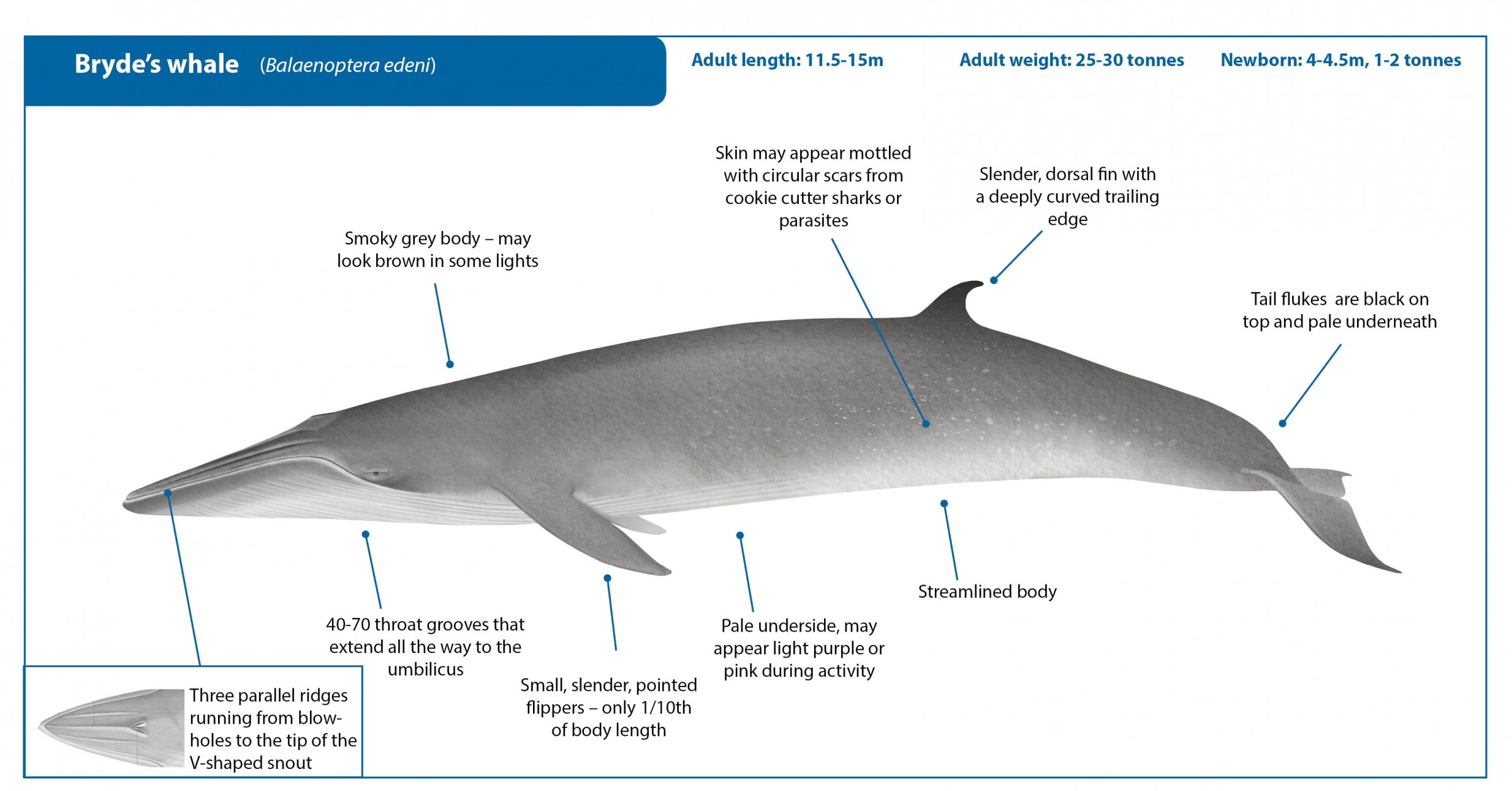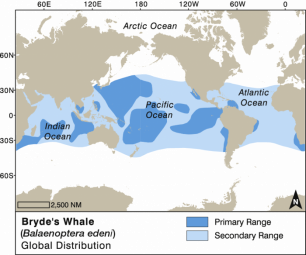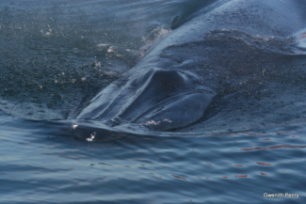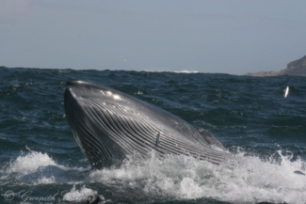Bryde’s whales are one of the most poorly understood baleen whale species. Also known as ‘tropical whales’, due to their preference for waters of 16° Celsius or higher, they are found in both nearshore and open waters between the latitudes of 40° South and 40° North. Historically Bryde’s whales have been confused with Sei whales, which are larger and have a more temperate and sub-polar distribution. Further confusion is caused by uncertainty about the possible existence of two species of Bryde’s whales, which have provisionally been classified as two sub-species with partially overlapping ranges: the smaller Eden’s whale (Balaenoptera edeni edeni), and usually larger Bryde’s whale (B. e. brydei) 1,2. Another species that was formerly confused with Bryde’s whales is the Omura’s whale (Balaenoptera omurai), which was only described in 20033, and can overlap in range with both sub-species of Bryde’s whale. While the taxonomists, geneticists and field researchers work to better understand this complex of species, whale watchers can hope to catch a glimpse of them in places like South Africa, New Zealand, the Gulf of Thailand and Brazil, where their range overlaps with some other more predictable and better studied whale species.

 Bryde's whale blow and surfacing pattern
Bryde's whale blow and surfacing pattern

References
Show / Hide References
- Kershaw, F. et al. Population differentiation of 2 forms of Bryde’s Whales in the Indian and Pacific Oceans. Journal of Heredity 104, 755-764 (2013).
- Mammology, S. o. M. List of Marine Mammal Species and Subspecies. Committee on Taxonomy https://www.marinemammalscienc... (2017).
- Wada, S., Oishi, M. & Yamada, T. K. A newly discovered species of living baleen whale. Nature 426, 278-281 (2003).
- Kato, H. & Perrin, W. F. in Encyclopedia of Marine Mammals (eds W. Perrin, B. Wursig, & J.G.M. Thewissen) 158-163 (Elsevier, 2009).
- Taylor, B. L. et al. in IUCN Red List of Threatened Species (http://www.iucnredlist.org/det... Downloaded on 9 October 2017, 2008).
- Best, P. Two allopatric forms of Bryde's whale off South Africa. Report of the International Whaling Commission, 10-38 (1977).
- Tardin, R. H., Chun, Y., Simão, S. M. & Alves, M. A. S. Modeling habitat use by Bryde's whale Balaenoptera edeni off southeastern Brazil. Marine Ecology Progress Series 576, 89-103 (2017).
- Best, P. B. Distribution and population separation of Bryde's whale Balaenoptera edeni off southern Africa. Marine Ecology Progress Series 220, 277-289 (2001).
- Elwen, S., Findlay, K., Kiszka, J. & Weir, C. Cetacean research in the southern African subregion: A review of previous studies and current knowledge. African Journal of Marine Science 33, 469-493 (2011).
- Moazzam, M. & Nawaz, R. Arabian Humpback and Baleen Whale sightings along the Pakistan Coast: Information Generated Through WWF Pakistan’s Fishing Crew Observer Programme. Report No. SC/67A/CMP/05, 16 (Bled, Slovenia, 2017).
- Sutaria, D. et al. Baleen Whale Records from India. Report No. SC/67A/CMP/03_Rev, 16 (Bled, Slovenia, 2017).
- Minton, G., Collins, T., Findlay, K. & Baldwin, R. Cetacean distribution in the coastal waters of the Sultanate of Oman. Journal of Cetacean Research and Management 11, 301-313 (2010).
- Penry, G., Cockcroft, V. & Hammond, P. Seasonal fluctuations in occurrence of inshore Bryde's whales in Plettenberg Bay, South Africa, with notes on feeding and multispecies associations. African Journal of Marine Science 33, 403-414 (2011).
- Penry, G. S., Findlay, K. & Best, P. in The Red List of Mammals of South Africa, Swaziland and Lesotho (eds M.F. Child et al.) (South African National Biodiversity Institute and Endangered Wildlife Trust, South Africa., 2016).
- Romanov, E. V. Bycatch in the tuna purse-seine fisheries of the western Indian Ocean. Fishery Bulletin 100, 90-105 (2002).
- Escalle, L. et al. Cetaceans and tuna purse seine fisheries in the Atlantic and Indian Oceans: interactions but few mortalities. Marine Ecology Progress Series 522, 255-268 (2015).
- Rosel, P. E. & Wilcox, L. A. Genetic evidence reveals a unique lineage of Bryde's whales in the northern Gulf of Mexico. Endangered Species Research 25, 19-34 (2014).
- Best, P. B. A Review of the Distribution and Population Separation of Bryde's Whale off Southern Africa. 1-16 (2005).
- Melly, B. L., McGregor, G., Hofmeyr, G. J. G. & Plön, S. Spatio-temporal distribution and habitat preferences of cetaceans in Algoa Bay, South Africa. Journal of the Marine Biological Association of the United Kingdom, 1-15, doi:10.1017/S0025315417000340 (2017).



